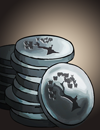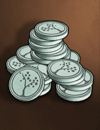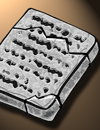The Fallen Cities
London is not the only city to be brought down to the Neath. Four other cities have come before it, all traded to the Bazaar for reasons unknown. Very few wish to consider the possibility of any coming after.
Traces of these former cities can be found, usually through their relics. First City coins, Second City tablets, Third City statues, and those ever-popular Fourth City horsehead figurines. Eager (and persistent) archeologists can find out more about these lost civilizations. The Fourth City is the easiest to learn of by far, as a remnant stands just outside the city: the Forgotten Quarter. The more adventurous zailors of the Sunless Sea may also choose to embark on a voyage to the Khanate, the floating city-state established by Fourth City refugees.
Neathy immortality also means that people from these cities have survived on into London as well, although a majority of their denizens have left for the Tomb Colonies. After all, these cities stretch far back into antiquity. Anybody who could survive that long and still remain a part of Fifth City life is either incredibly wily, powerful, or both.
The First City, date unknown
"Only two things are known to remain of the First City: the name, the Crossroads Shaded By Cedars, and the saying: even the First City was young when Babylon fell."


The First City is now generally considered to be Uruk, in Mesopotamia, after much debate. The remnants of the city live on in Polythreme. It must be assumed that the saying above was accidentally transposed over several hundred/thousand years.
A living survivor of the fall of the First City is the manager of the Royal Bethlehem Hotel, aka Gilgamesh. He orchestrated this fall to save the life of Polythreme's King With a Hundred Hearts, aka Enkidu. (The King is now a living statue with a diamond for a heart.) Another possible survivor is the Capering Relicker, who was the first to brew Hesperidian Cider.
The Second City, circa 1335 BCE
"Never mention the Second City to the Masters of the Bazaar. Mr Wines will look at you narrowly and give you its worst vintage. Mr Cups will fly into a rage. Mr Veils will harangue you for your discourtesy. Mr Iron will say nothing, only write down your name with its left hand."
"Certain of the Masters of the Bazaar - Mr Stones, Mr Apples and Mr Wines, and possibly others - seem to have a particular contempt for Egypt and the Egyptological. Perhaps they're simply reacting to the fashion for the Pharaonic that overcame London before the Descent. But it's unusual that they should care."

This city is definitely (El-)Amarna in ancient Egypt, judging by the snippets above and some interestingly intertwined facts about the Duchess and her family. The remnants of the city may live on in the Iron Republic.
A living survivor of the fall of the Second City is the Duchess (aka King Tut's youngest sister); she orchestrated the fall to save her husband's life. After falling out of favor with the Masters, he became the Cantigaster.
The Third City, 800s-900s CE
"No-one talks much about the cities that preceded London. The Third City seems to have been acquired a thousand years ago. It had five wells, they say. And the weather was better."
It is generally accepted that this Mesoamerican city was the Mayan settlement of Hopelchen (whose name literally means "five wells"), though some have proposed that it could be the more well-known city of Chichen Itza. The remnants of the city live on in the Elder Continent.
Two living/semi-living survivors of the fall of the Third City are the tomb-colonist Feducci and the Presbyter on the Elder Continent. It is unknown whose life was saved in exchange for the city, but it may have been one of the Mayan Hero Twins saving the other (which actually happens in the Popol Vuh!), or the deal may have been simply to give the priests power. The being that is now Mr Eaten was mostly destroyed in the fall of this city.
The Fourth City, 1388
"Who carves horse-head amulets out of bone? Whoever lived in the Fourth City. If all the Fourth City amulets on sale are real, they must really have liked horses."
The identity of the Fourth City has been conclusively proven in The Silver Tree (a standalone Storynexus game about the Fourth City) to be Karakorum, once a major Mongol city.
A living survivor of the fall of the Fourth City is the Gracious Widow (who is the daughter of Mongke Khan, and whose real name is Shirin). She likely orchestrated the fall to save the Once-Dashing Smuggler's life (he is now a tomb-colonist). Another possibility is that the Khan made the deal to save his city.
The remnants of the Fourth City live on in London's Forgotten Quarter, Port Carnelian, and the Khanate in the Unterzee.
The Fifth City, 1861
"The city around the Bazaar is called the Fifth City because, they say, it's not the first the Bazaar chose as a home. You can still turn up bricks from the older cities, now and then. Look: here's one marked with an eye."
There are numerous living survivors of the fall of London. It is widely known that Queen Victoria (the Traitor Empress) arranged the Fall to save Prince Albert (the Consort)'s life. Already the Consort seems rather wan, and something else (see bottom of linked page) has already befallen the royal family...
The Sixth City?
It was hinted in the July 2015 Exceptional Story, "Lost in Reflections," that Paris could be the Sixth City. The hints are compounded by the visions in the Temple Club. Well, that makes sense. After all, Paris is the City of Love.
Some content from NiteBrite/Mrs. Brite; most information from http://community.failbettergames.com/topic23-fallen-cities-a-great-many-spoilers.aspx.